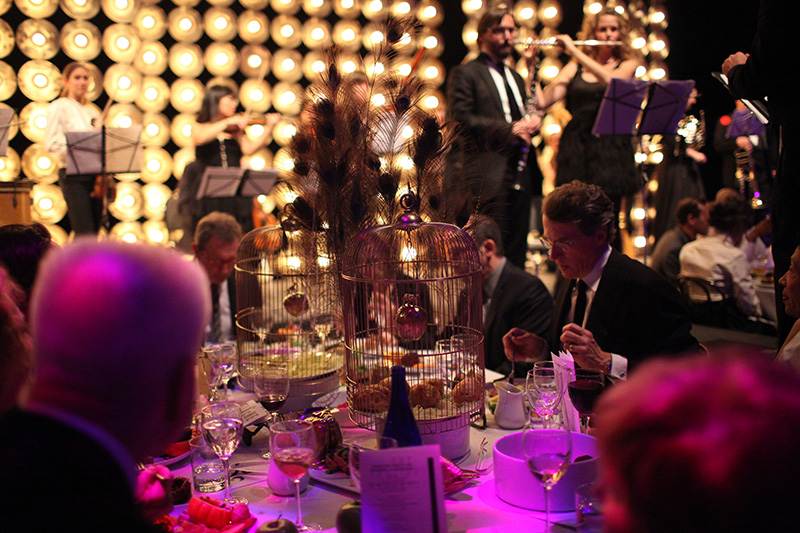With every bite, a bit of history
RoseLee Goldberg
To Cite this Article
Goldberg, R. (2016). With every bite, a bit of history. p-e-r-f-o-r-m-a-n-c-e, 3.
The Performa biennial, launched in 2005 in New York City as the first biennial of visual art performance, included food as a medium for engaging audiences with art history, and with each other, in its second iteration, Performa 07. That year Turkish artist Serkan Özkaya produced “Bring Me The Head Of…,” an apple sized dessert in the shape of a teddy-bear’s head, made in a special mold created by the artist and incorporated into the regular menu of Freemans’ Restaurant in the Lower East Side by chef Jean Adamson.

Serkan Özkaya “Bring Me The Head Of…,” 2007. Photo by Paula Court.
Since then, each biennial and annual gala has included works commissioned by artists to provide a gastronomical centerpiece to a performance, whether a one plate pasta course such as Marije Vogelzang’s “Pasta Sauna”,(Performa 09), or a more prolonged affair, such as An Exhibition in your mouth, by Ben Kinmont, (Performa 11), in collaboration with chef Ignacio Mattos of the Williamsburg restaurant Isa that offered Sol Lewitt’s cheese “Forms derived from a cube” and Toffee Pinecones by Salvatore Dali (1973). Overseen by Performa producing director Esa Nickle, each work has been a mix of historical references and culinary pleasures, resulting in unforgettable food centered evenings. Some highlights are described below.
Futurist Banquet …
Inside Park at St. Bart’s, February 2009.

The Futurist Banquet as seen during “Milk Bathed in Green Light,” 2009. Photo by Paula Court.
In 2009, on February 20, the exact date that the Futurist manifesto was published on the front page of the Paris newspaper Le Figaro one hundred years before, Performa threw an extraordinary dinner party for one hundred people to commemorate its publication. The Futurist Banquet celebrated the Futurists’ “love of danger, the habit of energy and fearlessness” and the group of young Italian poets, painters, and sculptors led by the indefatigable poet F. T. Marinetti, who wrote those words. The banquet also officially introduced the Futurist theme for Performa 09, taking the 100th anniversary as an opportunity to fulfill Performa’s mission of bringing history to life in the most original and inspiring ways.
At Inside Park, a restaurant situated in the refurbished Great Hall of the Community House at the historic St. Bartholomew’s Church on Park Avenue—with its soaring thirty-foot ceiling, decorative wall stencils, and stained-glass windows still intact from the hall’s original construction eighty-six years ago—renowned chef Matthew Weingarten, formerly the chef de cuisine at Peter Hoffman’s celebrated Savoy restaurant in New York, enthusiastically welcomed visitors with an inventive Futurist menu inspired by Marinetti’s sensational Futurist Cookbook of 1932.

Menu for The Futurist Banquet, 2009.
“We must invent new foods that induce happiness and optimism and multiply infinitely the joy of living,” Marinetti declared in the book’s introduction, which also denounced pasta as something that “weighs you down like a ball and chain.” During the 1920s and ’30s, Futurist chefs such as Luigi Colombo Fillia, Giacomo Balla, and Fortunato Depero, who were also painters and sculptors, created wild and creatively named dishes, the serving of which was accompanied by banging gongs, dramatic lighting changes, and even special scents strewn throughout the room or sprayed onto the necks or beneath the noses of diners.

“Intuitive Antipasto” appetizer served during the FUturist Banquet, 2009. Photo by Paula Court.
In response, Weingarten—a longtime supporter of local farmlands, sustainable culinary practices, and responsibly sourced ingredients, as well as an admirer of the Futurist Cookbook —fused the theatricality of the Futurists’ famous dinners with his own trademark use of seasonal ingredients and rustic cooking techniques. The evening began with a cocktail hour featuring unusual drinks such as “Alcoholic Joust,” during which the guests were invited to locate their assigned place setting featuring their own initials made of mortadella, caramel, pastry, and cheese. The appetizers served included “Edible Alphabet” and a “Cubist Vegetable Course,” followed by courses such as “Intuitive Antipasto” (orange rinds containing Futurist rallying cries on paper, which guests were invited to stand and shout during the meal), “Aerofood” (during which guests were asked to eat while attendants sprayed perfume in front of their noses), and “Milk Bathed in Green Light” (a sweet ricotta dish that guests ate while the room was illuminated with bright green lights).
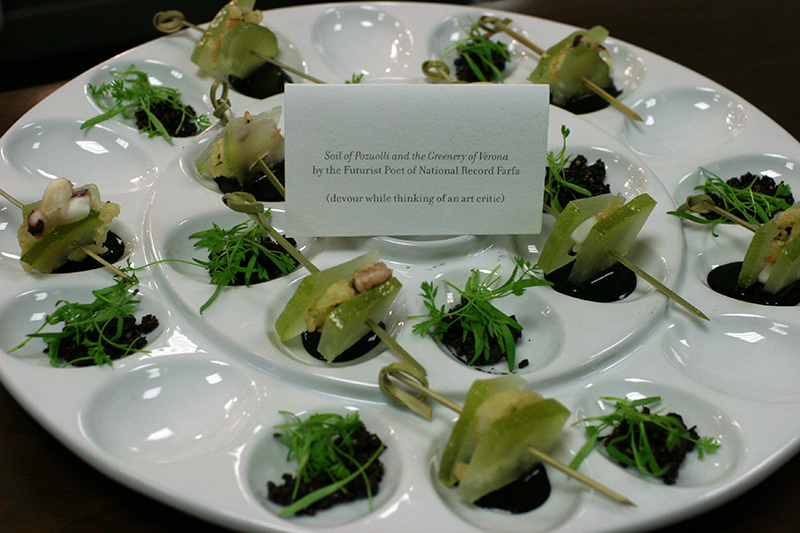
Soil of Pozuolli and the Greenery of Verona, an appetizer served at the Futurist Banquet, presented by Performa, 2009.
Photo by Paula Court.
The meal was interspersed with declamations of texts from the Futurist Manifesto and the Futurist Cookbook poem “Folgore’s Dazzling Appetizer.” Throughout the evening The Cangelosi Cards, a band that typically plays a mix of New Orleans–style jazz and 1930s cabaret songs but on this occasion incorporated Italian avant-garde references into their repertoire, performed onstage. Another highlight was a performance of Futurist poet Francesco Cangiullo’s Piedigrotta (1916) by composer and musicologist Luciano Chessa. An epic text considered to be the pinnacle of Futurist poetry, Piedigrotta takes the yearly Neapolitan street party dedicated to the Madonna di Piedigrotta as its subject, using onomatopoeic techniques to mimic the sounds of firecrackers bursting, street vendors shouting, a group of tenors singing, and mortars and shrapnel exploding, presenting the noise of the city as a living organism that is brought to a sudden halt when the procession of the Black Madonna takes over the stage. Chessa performed the poem with great aplomb, shouting and running throughout the space while he delivered its text.
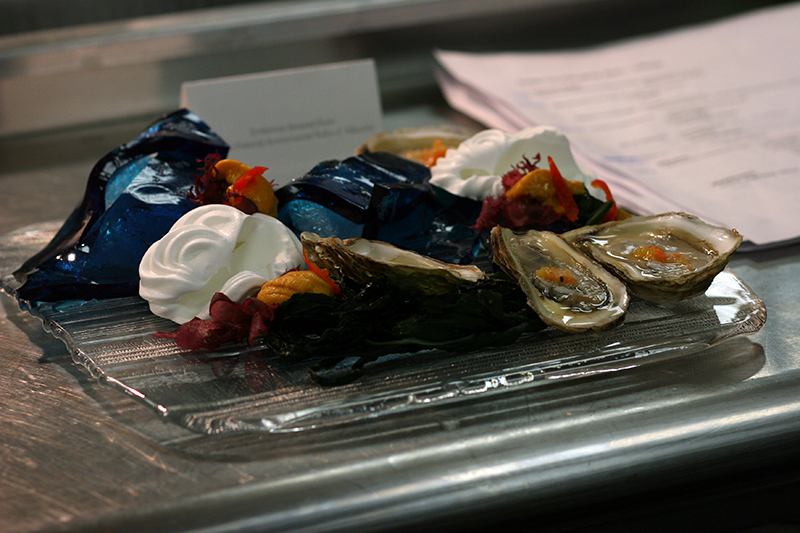
Tyrrhenian Seaweed Foam (with coral garnish), an appetizer served at the Futurist Banquet, presented by Performa, 2009. Photo by Paula Court.
The evening was capped off with dessert: a creation by British artists and Jell-O maestros Bompas & Parr, who reconstructed the Futurist recipe The Marinettian Bombe with orange Jell-O, angelica, fresh strawberries, candied chestnuts, and Campari, served with apricots and candied lemons. Using sophisticated Jell-O molding techniques—including perhaps the world’s first three-part Jell-O mold—Bompas & Parr provided a sweet finish to an unforgettable evening.
Creation
X Initiative, November 2009.

Invitation for details of Jennifer Rubell’s Creation, 2009.
The goal of Performa’s Opening Night is always to set the stage for a biennial that will palpably shift the mood of New York City’s cultural life, to declare the beginning of a three-week immersion into the imagination of visual artists. It is a night on which to fully submit to the fact that art gives significance to our everyday lives, not only to satiate our desires for aesthetic and visceral pleasures, but also as a means to express the complex humanism that shapes our consciousness.
For Performa 09’s Opening Night, Jennifer Rubell created an event that accomplished all of the above. Startling in its scale, interactive demands, and visual metaphors, her performance-installation took place on three vast floors of a building on Twenty-Second Street in Manhattan. The elements of the evening followed the order of a typical gala reception—“cocktails,” “dinner,” and “dessert”—but Rubell entirely upended these conventions. Also arranged in three parts, her Creation, inspired by the first chapters of Genesis, provided surprises every step of the way.
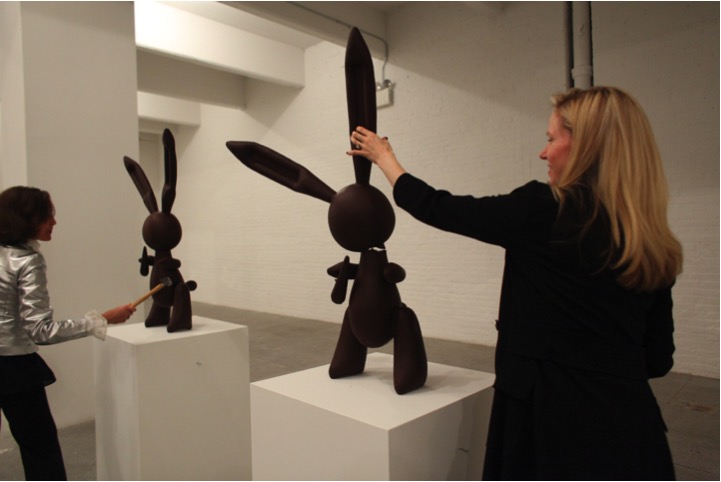
Details of Jennifer Rubell’s Creation, 2009. Photo by Paula Court.
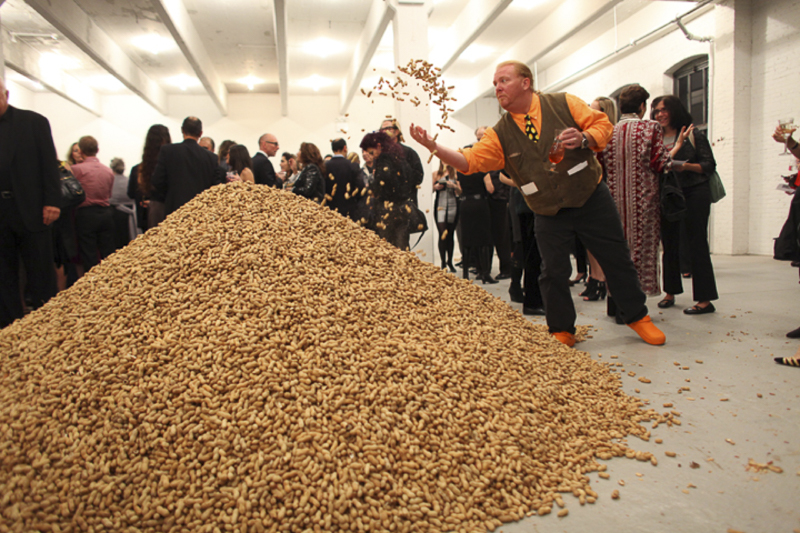
Details of Jennifer Rubell’s Creation, 2009. Photo by Paula Court.
The top floor, “cocktails,” was Rubell’s version of the “Garden of Eden,” where Adam might have tilled the ground. A giant mound of roasted peanuts in their shells, 3,600 glasses on a pedestal, one ton of ice cubes, and, in the 28-foot-long elevator, an expansive table of wine, liquor, and mixers were laid out for visitors to help themselves. For “dinner,” guests descended via the liquor elevator to the third floor, where the “Creation of Woman” (from Adam’s rib) was represented by one ton of spare ribs atop a massive pedestal, with honey raining from above. Five long tables, each seating one hundred people, were laid with pots running down the center that contained the side dishes, forks, knives, toothpicks, and napkins. A trio of water coolers, filled with red wine, white wine, and water, were set up to the side of the space.
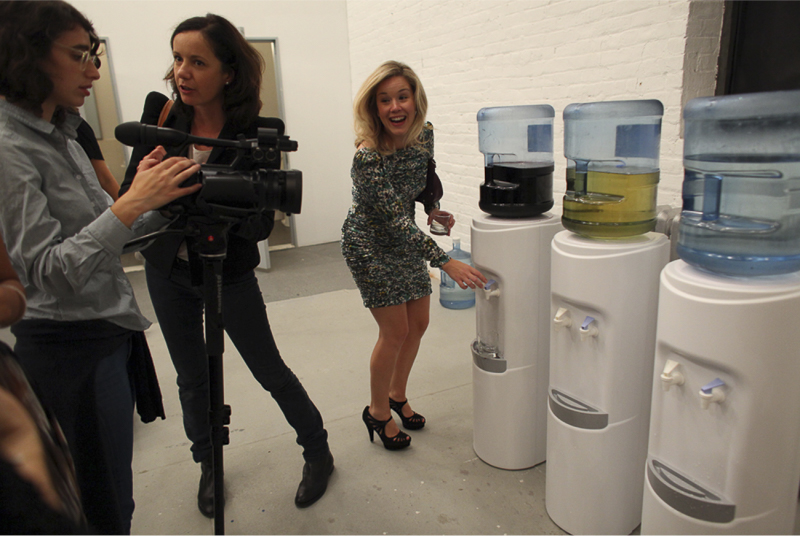
Details of Jennifer Rubell’s Creation, 2009. Photo by Paula Court.
For “dessert,” the liquor elevator opened onto the second floor, representing “Expulsion and the Fall”: a space elegantly strewn with three newly felled apple trees that had been brought in that day by a farmer on Long Island, with apples still attached to their branches. The healthful fruit could be eaten along with cookies plucked from three large industrial bags filled with sugar, and morsels of chocolate, once guests took up the hammers provided and started destroying the seven chocolate facsimiles of Jeff Koons’s famous Rabbit sculpture.

Details of Jennifer Rubell’s Creation, 2009. Photo by Paula Court.
“The project as a whole serves many functions,” noted Rubell. “As a commentary on the artisanal, the original, the unique and the appropriated; as an exploration of ways to engage art history through a medium (food) virtually absent from it; as a catalyst for a working interaction between viewers and objects, and viewers and each other; as a meal; and as a questioning of the boundary between art and all that exists to support it.”
The Red Party
SIR Stage 37, November 2010.
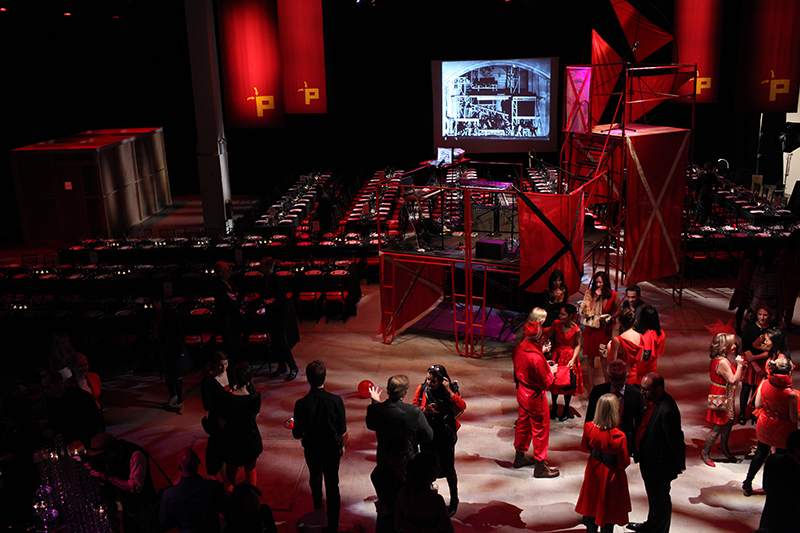
Guests arriving to The Red Party. Photo by Paula Court.
With each new biennial, I try to imagine the most direct, the most immediate way to involve people in the selected historical anchor of the biennial. How might we envelop people, in a single night, in a magical four or five hours, in the exuberant visions of artists from an earlier historical moment? Russian Constructivism of the 1920s provided an extraordinary menu of ideas, both intellectual and artistic, on which to build a three-dimensional night to remember that touched every aspect of that vast utopian project.

Table setting for The Red Party. Photo by Paula Court.
Looking to the art and productions of the most breathtakingly original artists of the period in all media—Kazimir Malevich, Alexander Rodchenko, Lyubov Popova, El Lissitzky, Vladimir Mayakovsky, Vladimir Tatlin, Varvara Stepanova, Vsevolod Meyerhold, Dziga Vertov, and Sergei Eisenstein, amongst many others—who took the revolutionary political framework as a launchpad for building an entirely new culture, our team got to work. Tatlin’s famous tower was alluded to in a floor-to-ceiling scaffold, serving as both watchtower and elevated podium for our agile master of ceremonies, the actor Alan Cumming; while the centerpiece of the party, inspired by The Magnanimous Cuckold, the mechanized theater “machine” designed by Popova, was perfect for staging performances by innovative artists of our own times: Robert Longo, Barbara Sukowa, Jon Kessler, Yvonne Rainer, Nick Hallett, and Zach Layton. Graphic highlights in the form of a series of banners hung from the high vaulted ceiling of the vast industrial space, recalling the masters of text-and-image combines, Rodchenko, Lissitzky, and the Stenberg brothers. Some guests brought the graphic theme to ground level, wearing especially made hats designed by Erik Bergrin based on Georgy Yakulov’s orbit-shaped headpieces for Giroflé-Girofla, Charles Lecocq’s nonsensical opera, directed by Alexander Tairov in full Constructivist mode in 1922.
Continuing the color palette, an entire dinner menu of red food was put in the mouths of diners for them to fully digest the critical mass of concepts being served throughout the evening. Pomegranates and borscht, a selection of tartares, and crispy parsnip pancakes, as well as the Russian national drink, vodka, in all shades of red, designed by culinary masters BITE and Producing Director Esa Nickle, preceded Jennifer Rubell’s coup d’grace desert: a walk-in “padded cell” lined with cotton candy, which had visitors tearing at the walls, recalling Stalin-era madness and the tragedy of Gulag prisons. Such reflections on the past and the present, on the playful and the profound, served as the starting point for a year’s worth of research that would be realized in all its complexity in the Performa 11 Biennial.
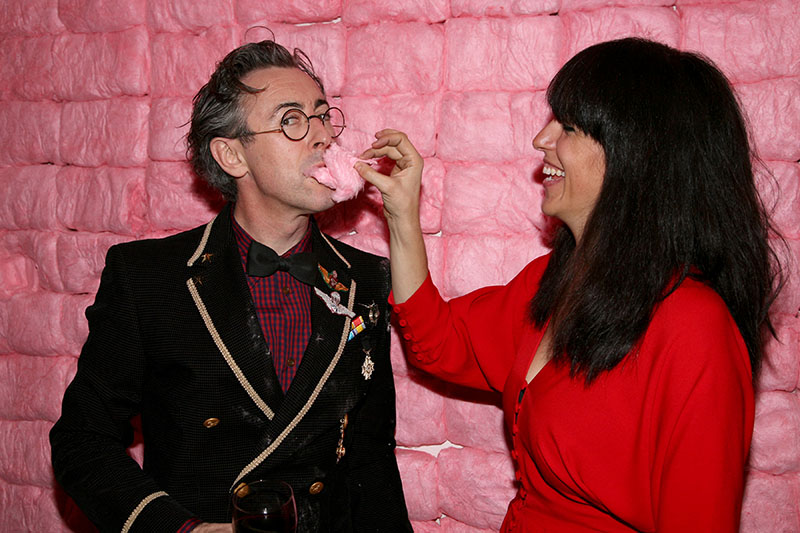
The Red Party MC Alan Cumming with Jennifer Rubell inside Rubell’s Edible Padded Cell, 2010. Photo by Paula Court.
Relâche
SIR Stage 37, November 2013.
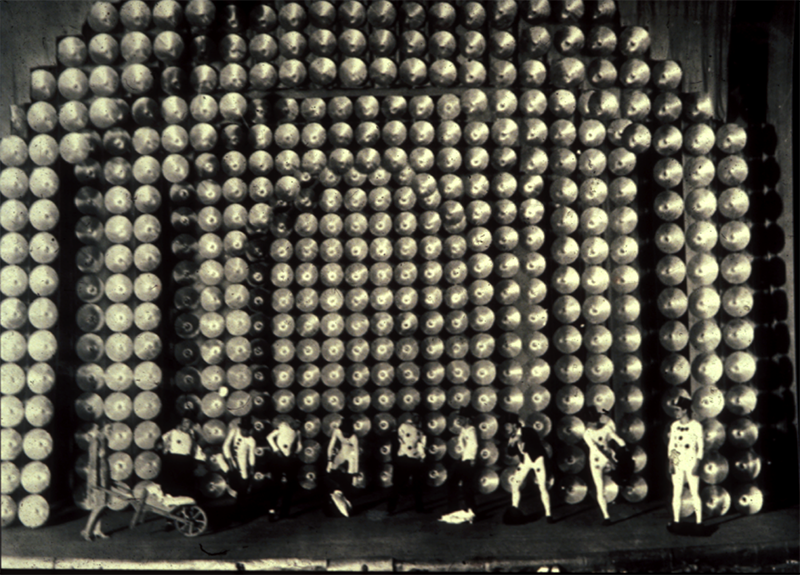
“Relâche,” set; Jean Borlin and Edith von Barnsdorff (1924).

Table setting for Ryan McNamara performing at “Relâche,” 2012. Photo by Paula Court.
On the evening of November 27, 1924, a large audience, including artists Marcel Duchamp, André Breton and Fernand Leger, arrived at the Théâtre des Champs Élysées in Paris for the opening of Francis Picabia and Erik Satie’s much anticipated Relâche. They were surprised to find the theater closed with a large sign bearing “Relâche” plastered across the door. There was much confusion; “relâche” is a theater term used to describe a dark night, and audiences assumed the double entendre was another Dada prank. No amount of banging on the doors got the theater to open; rather, the audience was informed that the first performance of Relâche was cancelled because the choreographer and lead dancer, Jean Börlin, was ill.
It could not be more ironic that 88 years later Performa had been forced to postpone its own Relâche, due to the disastrous aftermath of Hurricane Sandy which hit New York a fewdays before the scheduled gala dinner. Relâche-La Boume was to be a vibrant, re-imagined reconstruction of that famous evening, which Fernand Léger described as “a lot of kicks in a lot of backsides whether hallowed or not!” in his rave review of the performance when it ran a week later. He also pointed out that this provocative event “burst the watertight division between ballet and music hall. Actor, dancer, acrobat, screen, stage, all these different means for creating a spectacle came together and rearranged themselves,” he wrote.

Table setting for “Relâche,” 2012. Photo by Paula Court.
As with Relâche in 1924, Performa rescheduled its gala, and for more than 300 guests, it was an extraordinary introduction to an historic performance, as interpreted and reimagined by artist Ryan McNamara; the set of blazing electric lights was ingeniously recast with gold-painted LPs; fragments from Rene Clair’s film, Entre Act, from the original, were conjured with acrobats hanging from the ceiling, and the Surrealist inspired menu, with references to Savlador Dali’s cooked birds in gilded cages, and René Magritte’s perfectly painted green apples, kept the evening focused on the sheer imagination that drove the artists of Paris in 1920, as it did in New York in 2012. In Picabia’s words, the evening offered “perpetual movement, life, the quest for happiness; it is light, riches, luxury, love, removed from prudery and convention; without a moral for the fools, without studied artistic effects for the snobs.” For Performa it was another thrilling occasion to realize one of its key missions, to show the history of performance past, and to bring it into the present in the most immediate and visceral ways.
Foie gras- and mushroom-stuffed quails were served from gilded birdcages at “Relâche,” 2012. Photo by Paula Court.
About Performa
Founded in 2004 by art historian and curator RoseLee Goldberg, Performa is the leading organization dedicated to exploring the critical role of live performance in the history of twentieth-century art and encouraging new directions in performance for the twenty-first century. Since launching New York’s first performance biennial, Performa 05, in 2005, the organization has solidified its identity as a commissioning and producing entity. As a “museum without walls,” Performa provides important art historical heft to the field by showing the development of live art in all its forms from many different cultural perspectives reaching back to the Renaissance. The Performa Biennial is celebrated world wide as the first biennial to give specialized attention to this remarkable history, transforming the city of New York into the ‘world capital of artists’ performance’ every other November. Performa attracts a national and international audience of more than 200,000 and receives more than 5,000,000 website hits during its three week run. In the last decade Performa has presented 592 performances, worked with 732 artists, and toured commissioned performances in 17 countries around the world.

